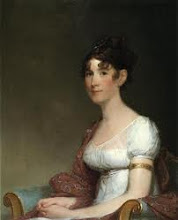Synopsis (From Chapters.indigo.ca):
A.D. 69. The Roman Empire is up for the taking. The Year of Four Emperors will change everything-especially the lives of two sisters with a very personal stake in the outcome. Elegant and ambitious, Cornelia embodies the essence of the perfect Roman wife. She lives to one day see her loyal husband as Emperor. Her sister Marcella is more aloof, content to witness history rather than make it. But when a bloody coup turns their world upside-down, both women must maneuver carefully just to stay alive. As Cornelia tries to pick up the pieces of her shattered dreams, Marcella discovers a hidden talent for influencing the most powerful men in Rome. In the end, though, there can only be one Emperor...and one Empress.
Avid Reader's Review
4 Stars
Kate Quinn's latest novel of ancient Rome takes place in the year 69 AD or, as it's better known, the Year of the Four Emperors. Daughters of Rome follows the lives of two sisters, Cornelia, who is wife to a man who could one day be Emperor, and Marcella, who likes nothing better than to spend her days writing histories of Rome's emperors. It is also the story of their two cousins, Lollia, a frivolous young woman who, at the start of the novel, is preparing for her third wedding, and Diana, who cares for nothing but horses and her beloved Reds chariot team.
The novel opens during the reign of Emperor Galba, a reign that was lasted only seven months and was brought to a bloody end when a coup resulted in the Emperor's assassination. This coup not only resulted in the installation of a new Emperor, Otho, but also served to turn the world of Cornelia, Marcella, Lollia and Diana upside down. Would each of these women survive and prosper in Rome's new order?
Having previously read and immensely enjoyed Kate Quinn's debut novel, Mistress of Rome, I eagerly awaited the arrival of my copy of Daughters of Rome. I'm happy to report that I wasn't disappointed as the author has delivered yet another winner. Each of the characters featured in the novel are vividly drawn, leaving the reader engaged in their story lines and interested in their fates. In addition, Quinn has created a strong sense of time and place with this novel, as she not only captures the splendor and extravagance that defines ancient Rome, but also its political ruthlessness.
Not being familiar with this period in Roman history I appreciated Quinn's author's note, as it explained what was fact, what was fiction and what was a blending of the two. It is my understanding that Kate Quinn is already at work on her next novel of ancient Rome, and having enjoyed her first two efforts I most definitely look forward to reading her third!
skip to main |
skip to sidebar










Blog Design by: Pixel Me Perfect
Pages

- Melissa @ Confessions of an Avid Reader
- I love to read and discuss books. My favourite genres are historical fiction and fantasy.



5 Stars: Loved it!
4 Stars: Really enjoyed it
3 Stars: Liked it
2 Stars: Didn't like it
1 Star: Hated and probably didn't finish it
Note on my reviews: Unless otherwise noted, all books reviewed come from my own personal collection.
4 Stars: Really enjoyed it
3 Stars: Liked it
2 Stars: Didn't like it
1 Star: Hated and probably didn't finish it
Note on my reviews: Unless otherwise noted, all books reviewed come from my own personal collection.

.
-
She spies for General Washington, betrays the Redcoats and battles for America's independence... It's 1777, and a fledgling cou...
-
In a small Bihari village, Captain William T. Meadows finds just the man to further his phrenological research back home: Amir Ali, confesse...
-
Synopsis : The Waste Land chronicles the adventures of Hugh de Verdon, monk turned knight, during the extraordinary historical events o...


-
-
-
The latest on Substack2 months ago
-
BEST BOOKS OF 202410 months ago
-
A fond farewell…1 year ago
-
-
-
-
-
-
-
-
-
Reading Journal #6: Catching Up10 years ago
-

2011 British Books Challenge
2011 chivalrous deeds challenge
2011 historical fiction challenge
2012 Historical Fiction Challenge
2012 Mount TBR Challenge
Book Blogger Hop
British Books Challenge
historical fiction
Mailbox Monday
miscellaneous musings
review
Suddenly Sunday
Travel Tuesdays
Waiting on Wed


















